You are reading the older HTML site
Positive Feedback ISSUE
16
november/december 2004
Critical Waves:
The 2004 AES Show in
San Francisco (page 2)
by
Scott Dorsey
Photographs by Dorsey; image processing and frescos by Robinson
SPEAKERS
Genelec was introducing a new line of speakers that is replacing the lower end of their 1000-line, called the 8000 MDE series. These are two-way active speakers ("active" meaning they have internal amplifiers) and much smoother on the top end than the old 1030 and 1031 speakers. I was actually quite impressed with the sound; the top end was clean and detailed, and the bottom end did not appear to have the narrowband organ pipe resonance problems that some of the older models did. Unfortunately they didn't have the S30 ribbon tweeter monitor there for me to do comparisons with (although they did assure me there was no intention of discontinuing the S30 any time soon), so I did not have a good comparison reference. They are built into die-cast metal cabinets, which immediately make me suspicious, but there did not seem to be any obvious body resonance problems. They seemed to have a rather narrow sweet spot, but had a convincing image within it. These new speakers are definitely worth checking out, and unlike the 1000-series, they are all voiced to sound as similar as possible (though obviously the larger ones have better bass extension).
Incidentally, in the papers sessions, Andrew Goldberg, Aki Makivirta, and Ari Varla from Genelec gave a talk called Compensating the Acoustical Loading of Small Speakers Mounted Near Desktops. They showed how speakers placed on a computer desk or above a mixing console had some problems due to reflections from the surface below them. They showed a method for using a digital notch filter to compensate for the resulting frequency response problems; this does not really fix the issue but it actually results in better total system impulse response and improved sound in cases when there's no way to actually fix the problem. In an age where desktop audio systems become more popular every day, it's at least an interesting look at the problems. Preprint 6181.
Miller and Kreisel came out with a small powered loudspeaker, much smaller than any of their previous monitor designs. Called the MPS-1611P, it looks like it could be as fine a design as their previous monitors although it was very hard to tell anything under the show conditions. These guys are very much into ported enclosures that can be turned into sealed enclosures at the user's option, which can be a very handy thing when you are working in the field in a variety of improvised rooms with different low end characteristics.
Alcons was showing their QR18 speaker systems, which were large PA cabinets with extremely long (18") ribbon drivers for narrow dispersion applications. I have liked the Alcons ribbon PA systems a lot in the past and these look like another useful tool, especially when dealing with very reverberant spaces. The clean midrange response of the ribbons is very hard to beat, and they give you pattern control that is as good as a horn system. Nat Hecht is with Transmission Line Marketing, which is the US distributor, and I talked with him a little bit about the problems with his web site and my problems getting rental on the wonderful Alcons speakers.
Lukas Lipinski of Lipinski Sound was showing off their L-707 studio monitor, which is a custom-designed tweeter from Vifa in a foam mounting recess for time-alignment, arranged in a D'Appolito arrangement with a pair of 7" glass fibre woofers. They were driving them with their L-170 monoblock amplifier, and the sound was very good; I think these folks may well have got the best sound in show if they'd have been in a better environment rather than out on the show floor. These are definitely very analytic sounding studio monitor speakers that may well be worth looking into for a home system as well.
Focal had the SM8 powered monitor on display; I have mentioned this in previous show reports but I still like the general design of these speakers and I have still not had a chance to hear them in a good environment where I could get a sense of how they perform.
Once again, Magnetic Audio Devices was showing a very impressive large array of magnetoplanar drivers for large concert applications, although they still did not have any literature on them or any real information about the driver construction.
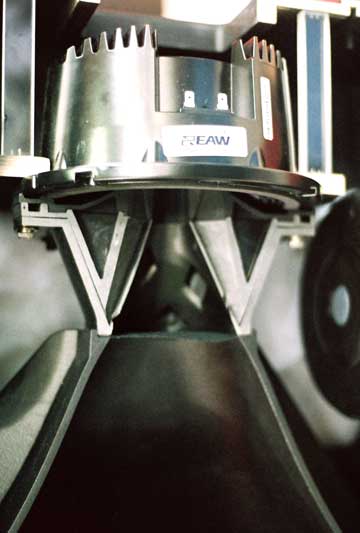
The EAW AX Series speaker, a compound horn assembly that's intriguing to look at…
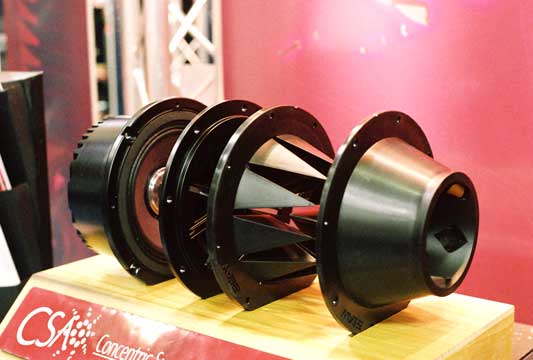
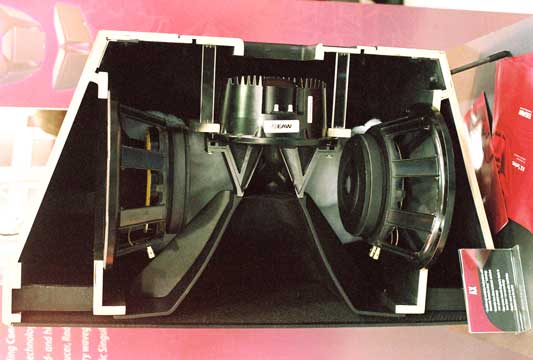
...intriguing, indeed!
EAW had a very interesting display. Their new AX series speakers consist of a coaxial driver with an integral compression driver behind a midrange cone, but what makes it most interesting is that this driver goes into a large phasing plug assembly and into a larger horn. They didn't have the system available for listening, but mechanically it was quite interesting and it would be interesting to see if the pattern control was as tight and accurate as they claimed.
TOA of all people had a small inexpensive monitor speaker as well. Their ME-120 and ME-160 speaker systems were compact and seemed like really quite respectable designs. The ME-160 was a two-way system, and the ME-120 was a very odd full-range driver in a bass-reflex cabinet. I wish I'd been in an environment to listen to these systems properly. They looked like the first serious offering from TOA in a good long while.
JSX was showing some cinema speakers that were based on the TAD/Pioneer 2001 compression drivers, but using their own horns rather than the TAD wooden horn designs, and with extensive DSP processing. There was no way I could tell what they sounded like under show conditions, but they could be a start in a high-end home theatre system. These folks also sell a balanced power box called the HDP7.
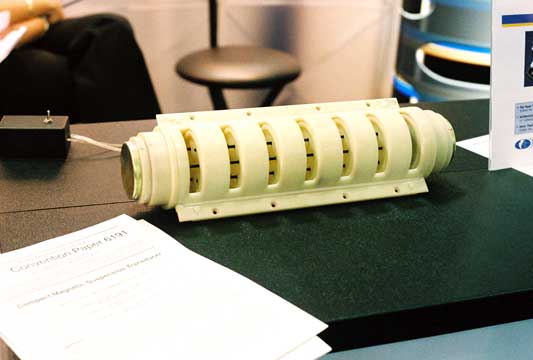
The Tymphany bass driver: like a Heil ESS on steroids! It'll curl your hair, too, in both senses of the phrase…
Tymphany had on display a prototype for a bass driver which consisted of a number of opposed diaphragms which were driven by linear actuators on either side of a slitted cylinder. This acted almost like the old Heil ESS drivers in that it made a set of small bellows that took in and expelled air at a given frequency. Andrew Unruh and Robert True wrote a paper on analyzing several variants of this system, which was published as Loudspeaker Transducers with an Alternative Tubular Form Factor, Preprint 6250. The idea looks very interesting as a bass driver and their test models went up to comparatively high frequencies, although they had no distortion analysis on the system. Sadly I missed the off-site demo that Tymphany was giving, because their hotel was involved in a hotel workers' strike and I wasn't willing to cross the picket line, but I hope to listen to the system at some point.
Ali Jabbari and Andrew Unruh from Tymphany also had a paper entitled Jump Resonance in Audio Transducers, preprint 6247. They had noticed sudden jumps in the amplitude of driver excursions when operated near the driver's resonant frequency and hypothesized that this was due to a driver nonlinearity of some sort. When the resonance frequency is approached from one direction (say, by a rising tone), there is an increase in level, but when it is approached from the other (say, by a falling tone), there is a decrease. These folks set up a nice mathematical analogue of a driver using the Matlab/Simulink modelling tools from the Math Works and showed exactly what sorts of spider and surround nonlinearities can cause these jumps.
Tsakiris Vassilis and Orinos Chris from Crystal Audio talked on Optimum Loudspeaker System with Subwoofer and Digital Equalization in which they used some digital room equalization systems in order to bring the crossover point on consumer stereo subwoofers up to 120 Hz. They did a surprisingly good job of getting flat response in a wide area, but they did nothing to look at impulse response and they did nothing to look into imaging effects, which are very significant even with an 80 Hz crossover. Preprint 6266.
Taking a totally different approach, Jonas Brassch, William L. Martens, and Wieslaw Woszczyk from McGill University have taken the general observation that the mono subwoofer, when crossed over at any reasonably high level, results in a mono image at low frequencies. They then went to quantify the issue and determine how easy it was to localize the subwoofer in an installation using noise bursts centered on 31.5, 63, or 125 Hz frequencies. They recorded the room using a binaural microphone pair, and found that clear localization of the sub was possible just by looking at interaural time differences and that this could easily model the audible effects. In Modeling Auditory Localization of Subwoofer Signals in Multi-Channel Loudspeaker Arrays they point out the importance of using more than one subwoofer in order to get actual imaging at low frequencies. Preprint 6228.
On a very different note, Alexander Voshivillo did a wonderful job of surveying the various distortion modes in horn speakers and compression drivers, and giving good quantifiable math models for each one of them. In Comparative Analysis of Nonlinear Distortion in Compression Drivers and Horns he did a wonderful job of putting all of the various known distortion modes together in one place, showing the individual distortion products from each of them separately, and where they come from. Preprint 6192.
Keiichi Imoka and Juro Ohga from the Shibaura Institute of Technology in Tokyo had a poster up about A New Digital Measurement for Distortion of Acoustical Devices. These guys were doing something more or less the opposite of the traditional intermodulation distortion test: they generated a signal with digital synthesis which consisted of pink noise with two narrow bands removed, then looked at how much signal appeared in the empty bands when the signal went through a nonlinear transducer (in this case a speaker). I have to admit that I had some difficulty following Mr. Imaoka's English so I don't have a very good hang of how this models various nonlinear effects (you're looking at both intermodulation and harmonic effects together at the same time), but it looked quite interesting. New measures to quantify audible distortion effects are always welcome. Preprint 6216.
One source of speaker distortion effects is that the impedance of the voice coil differs with frequency and the position of the coil. The load that the crossover and amplifier see is not linear and changes at different points in the waveform. Mark Dodd, Wolfgang Klippel, and Jack Oclee-Brown try to quantify these effects with a finite element model in Voice Coil Impedance as a Function of Frequency and Displacement. Preprint 6178.
Probably the most head-scratching that I did at the show came from Sean Olive's paper, A Multiple Regression Model for Predicting Loudspeaker Preference Using Objective Measurements: Part II. Mr. Olive talks about a number of earlier models which attempt to quantify the "goodness" of speakers using objective models, and he shows some problems with them. Most notably, he touches on the notorious Consumers Union speaker testing model. He shows a much more accurate model that correlates roughly well with perceived quality over a wide range of speakers. Note that this is not a test to determine subtle differences between quality speakers, but a test to evaluate comparatively gross differences in a repeatable and objective way. And it is a test that completely neglects imaging effects and radiation pattern. Even so, it is the rough beginnings toward a measure of objective speaker quality and that measure is needed to help speaker designers know what the basic guidelines to design for are. Among other things, he shows that flatness of the third-octave response of a speaker actually correlates negatively with perceived quality. Preprint 6190.
Some similar work (using some models with are partially based on Mr. Olive's earlier work) was done by Preben Kvust and five others, in Development of a Sound Quality Evaluation System. They measure 16 systems in an anechoic chamber and attempt to correlate these measurements with listening tests made by one skilled listener, albeit under different listening conditions. They do spend time looking at directional data and the off-axis response and do build this into their model. Overall correlation didn't look so good, but it's a valiant first try. They do however note that it's far from being possible to eliminate subjective listening tests. Preprint 6238.
MAGAZINES
One of the great things for me about the show is hanging around with the press people, and seeing magazines that are not even distributed in the US. I finally got the meet Larry Crane from Tape Op, and of course to hang out with Lorenz Rychner and Mike Metlay from Recording magazine which occasionally publishes my work. Live Sound also had someone there, and I want to put in a good word for them because they are one of the smaller and less-known publications in the field, but they make a serious attempt to have real technical content. Bill Whitlock managed the editorial coup of the year by getting the same article in issues of Radio World EE Extra and Live Sound that were available at the show. Sound and Communications, a publication oriented to the installed sound market, was there. Also EQ and Mix, of course. Voice Coil, a magazine for speaker designers and manufacturers had a small presence, and Millimeter, a journal for film and video production and post work was there.
But the best are the European magazines, in part because they seem to take technical issues much more seriously and don't seem as beholden to advertisers. Audio Pro, a magazine published out of the UK, even had an article about speaker power ratings being poorly done by manufacturers. You'd never see something like that in an American magazine.
Resolution, possibly the best audio magazine I know of today, but one which is next to impossible to find in the US, was there and handing out some of their latest issue. Sound On Sound and Audio Media, two more UK-based magazines were there. But there was also a really nifty Canadian magazine called Professional Sound, and something called Mondo*dr, which was a UK-based magazine with serious Italian and Asian connections. It was primarily oriented toward show production and so there was a lot of discussion of lighting and video presentation as well as sound, but what made it very interesting were the number of direct advertisements from Chinese manufacturing facilities doing direct distribution. A lot of items for sale, both Asian and European, that won't be seen on these shores any time soon.
An interesting contrast was in the issues of Total Production, which is a UK-based magazine again oriented at the show production market. But these folks had an international edition and now a special American edition and it was a lot of fun to compare the two of them both in layout and in overall slant.
MICROPHONES
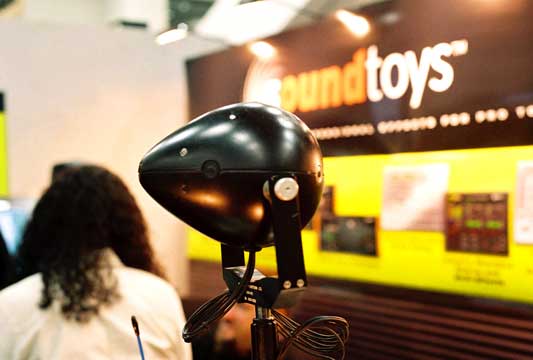
The Holophone H-2 Pro surround microphone.
Rising Sun Productions was showing off the Holophone H-2 Pro, a baffled array based around an elliptical foam device that is capable of producing 5.1, 6.1, and 7.1 surround audio. In some ways it seems to work more or less like the Schoeps Sphere in that there is a large baffle that effectively changes the pattern of the microphone set. Of course, the Holophone has far more channels, and their demo recording did seem to throw a respectable image. Johnathan Godfrey was very willing to talk about them, and show off their little remote-controlled robot with a wireless holophone on it.
Arnaud Laborie, Remy Bruno, and Sebastien Montoya from Trinnov Audio in Paris talked on Designing High Spatial Resolution Microphones. The interesting part of this talk was that they described the basic requirements for a multichannel microphone system that would give realistic image representation for 5.1 playback, with some mathematical background. The less interesting part was that they showed a method of modeling the ideal microphone set with an array of omnidirectional microphones with a filtering matrix rather than using baffling or controlled directivity. Preprint 6231.
NADY was showing their RSM-2 ribbon microphone, which promises to be the least expensive ribbon mike on the market and which didn't sound too bad in a quick listening test on the show floor. Jennifer Lee was very helpful in showing the mike off.
Wes Dooley from AEA was showing their R88 dual ribbon microphone, which appears to be two R84 microphones built into a single case for Blumlein stereo in a single package. Josephson was showing their new C617 microphone, which consists of their high grade Series 6 microphone with an adaptor to handle a measurement microphone capsule, and a modification to power the capsule at a full 200V polarization. It is shipped with a Gefell Type I measurement capsule with a nickel diaphragm, which has a phenomenally flat off-axis response and is the most accurately omnidirectional microphone around. I have always been a fan of this type of capsule, and the C617 allows you to use these capsules at full polarization voltage with standard phantom powering. There is no need to fiddle around with external power supplies and unbalanced lines, like with modifications to older measurement microphones.
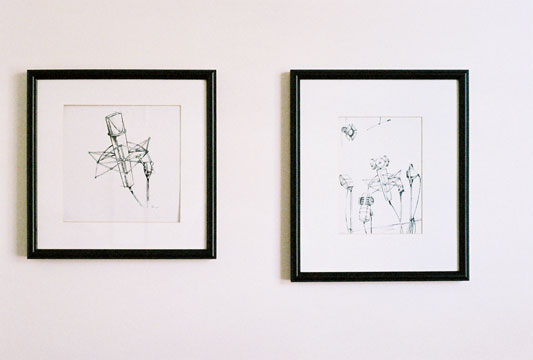
Speaking of microphones, here are a couple of prints from my hotel wall: some very decent renditions of the thing itself.
The Sound Room sells Oktava microphones as well as the Sabra-Som shockmounts and supports, and what was mostly new with them is that they are under new management. Taylor Johnson, the previous owner, has been trying to transfer ownership of the company for a while now so that he could go to Argentina and continue working on the THE microphone line. He had passed most of the business on to his partner, Elizabeth Papatrou, when she sadly died of a heart attack at a most inopportune time. However, he seems to have transferred the business to a Polish family who really seems to care about the customer and who want to continue operating it as a family business.
Qunli Wu of BSWA Technology (Beijing Sheng Wang Acoustic) was showing off something of a bargain basement version of the same idea. Their SM4000 uses a cheaper measurement capsule with a nickel diaphragm but with a back-electret so no polarization voltage is required. The capsules they supply looked a bit cheaply-made, with die-cast cases rather than carefully-machined materials, but it still may be a good way to get good omni performance at a reasonable price for recording work.
GRAS and ACO were both showing more conventional measurement microphone kits, with a variety of free-field and pressure measurement capsules and electronics for unbalanced outputs, with a variety of different sizes and powering.
Out on the papers sessions, Roger Grinnip from Shure gave a fine talk called Advanced Simulation of a Condenser Microphone Capsule. He gave a good math model describing a simple omnidirectional capsule, which was a synthesis of a number of other models from outside sources. He did a fine job of basically taking a lot of different models and synthesizing a newer and slightly more accurate one from them, although he did not address any vented capsule designs. In spite of a heckler who repeatedly berated him for contrasting his model with an artificially bad example, it was a fine overview of the technology. Preprint 6254.
MIXERS
Nautilus Master Technology makes a very nice little 2U high mixer with 12 inputs, 8 of which have individual pan and mute. A very clean little minimalist design. They call it the Commander.
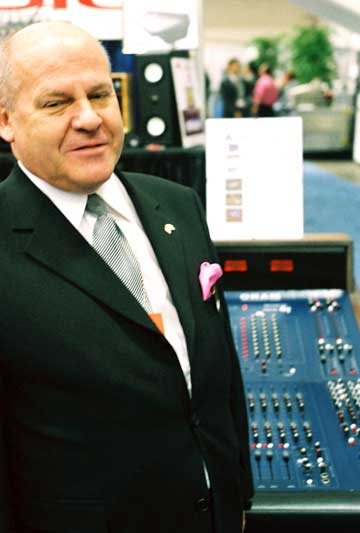
John Oram of Oram.
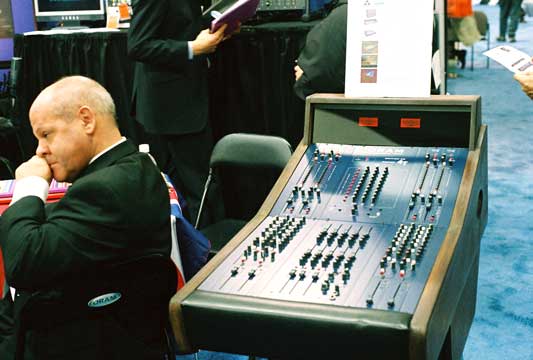
Oram with one of the Oram consoles.
And, John Oram is now handling both the Oram console line, which seems very nicely designed in spite of some serious growing pains on earlier models, and an update on the older Trident mixer line. What's most interesting about this is that he's now offering the ability to mix and match modules, so that you can purchase a Trident mixer with forty-six channels of Trident EQ and two channel strips set up with Oram EQ. It's a very nice way to set up different channel configurations that complement one another.
Brad from Transamerica Audio Group was showing some of the new products from ADT. They make a nifty rackmount mixer called the Integrator which is very slick and modular, as well as some smaller consoles like the BC-SRD broadcast mixers and BC3 compact modular consoles, and some large studio consoles. Sadly most of this gear was not on display and only limited information on it was available, which is sad since it would certainly have been some of the most interesting products in the show.
What was most amazing is that these were pretty much the only real new mixer products at the show. There were a whole lot of new control panels for digital audio workstations, but not many actual mixing products.
MONITOR CONTROLLERS
Coleman Audio makes a whole line of really neat switching and routing things. Imagine, if you will, a home "line level preamp" with balanced inputs and outputs, and pushbutton routing. They make a gadget like that called the PS1A monitor controller, and it's a fine thing for people using digital workstations or low end consoles without real monitor routing. Sadly it lacks a "mono" button although their fancier M3PH has one. They also do surround level controls, surround switching gadgets, VU metering, speaker switching, and everything else you need for studio monitor routing.
Nautilus Master Technology is also making a very slick-looking device called the DMC-8, which has both unbalanced and balanced sources, mono button, mute button, VU meters and a dimmer control for the lighted meters and pushbuttons. What makes this especially interesting is that it gives you the ability to switch between two speaker systems as well, with independent level controls so you can compare material through two level-matched speaker arrangements.
RETROFIT STUFF
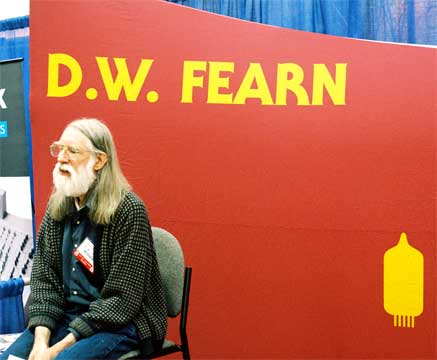
John Hardy has come out with their 925 card, which is a replacement for the API 325 amplifier card that was used as a general purpose amplifier card in a lot of API gear. It's not only a good retrofit, but it's a handy audio building block and it also has an optional mike input transformer so it can be used as a mike preamp as well. There is also an RIAA network, which can turn it into a very fine quality phono preamplifier board.
Martinsound re-introduced upgrade kits for EMT-140 echoplate mechanical reverb units. These kits include new pickup transducers and a completely new set of electronics with clean balanced inputs and outputs. For folks using the old EMT plate reverbs, many of which are becoming difficult to maintain today, this could be a big step up in both sound quality and maintainability.
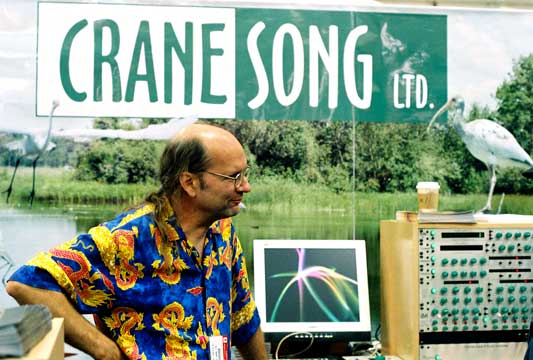
MASTERING MODULES
There are a number of companies now making new modules for mastering processing. These are small processing board which fit into a rackmount unit. Now, there is an old Neumann standard for form factor and interface on these, but I am not sure any of the new folks are using them, and their sales guys did not know. So I don't know if any of these modules will fit into an existing mastering console, but they can surely go into their own racks. These are all modules intended for coupled two-channel processing.
Billy Stull of Legendary Audio in Texas is selling some modules designed by Rupert Neve. They have an input module with a stereo width control (which appears to just be a fancy matrix that can add or subtract L-R signal, something that is very handy), a compressor-limiter module, an equalizer module, and then a couple very unusual things. The 1710 module has a tape saturation emulator (something I am kind of suspicious of), but it also has an all-pass network that allows the engineer to compensate for group delay in the original recording. This can be a very powerful tool for LP mastering. Another interesting module is the 1515 peak equalizer module, which allows you to equalize only signals above a threshold, which can be very useful in salvage work for cleaning up the effects of mastering with bad limiting. All of the controls have 1 dB and 1/4 dB steps for precise matching between channels, and the modules are all transformerless.
I mentioned earlier about ADT, a German company which is now being imported by Transamerica Audio Group. They make a very nice mastering rack, called the V700. What's most interesting about this is that there is a huge array of modules available, including things like noise gates, single ended noise reduction systems, exciters, ring modulators, and other wackiness. I have not seen this variety of different stuff available for one rack for a long time, and it even outdoes the old SCAMP rack in terms of having strange modules. Stepped controls are available on these units, but only as an option, so if you want to use these for non-mastering applications you can take the less expensive route. This is a very well-developed system that looks like it has been around for a good while and had the bugs worked out of it, but I have never seen it on American shores before. This is one of the more exciting products this year.
TRANSFORMERS
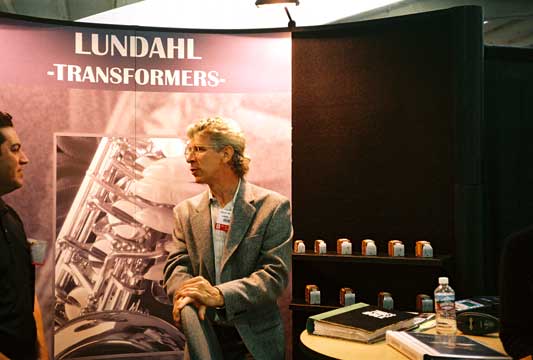
Kevin Carter of Lundahl Transformers.
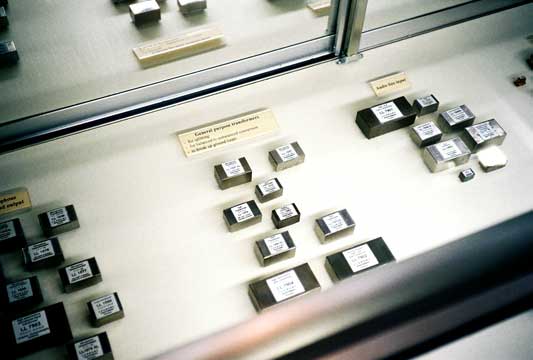
Some of the Lundahl trannies on display at AES 2004.
Lundahl was introducing a new line output transformer series for tube amplifiers driving 150 ohm or 600 ohm lines. The 1689 has a variety of input taps for various tubes in the 6V6 through EL34 range, and 150 or 600 ohm outputs. It can be ordered in an optional single-ended configuration as well. They also had on display their usual excellent line of high grade audio transformers in various configurations. Not only was Per Lundahl himself at the show, but his US distributor Kevin Carter was there.
Brad Jolly from Plitron was showing off their line of high grade power and audio toroidal transformers, and also a huge toroid which I suspect was really a truck tire with windings around it. I have always liked their products, especially their tube audio output transformers, but I am pleased to see they are now making power transformers with deliberately limited bandwidth to filter high frequency components from the power line, which is definitely a very good move for power supply designers.
Sunrise International had a line of power transformers made in China although they didn't seem to know very much about them. I talked with Roger Wu about wideband audio transformers (and I know Sunrise at least makes 70V distribution transformers for PA gear), but he didn't seem to know much about that line.
WACKY STUFF
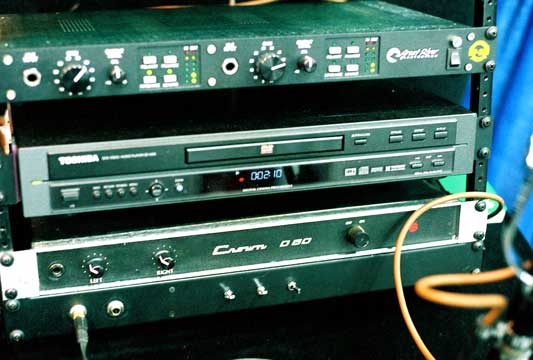
Speaking of wacky: an old Crown, yet…
Network Sound makes a little board which allows you to take up to 32 channels of PCM audio over an I2S link, and transmit it over Cat-5 cable to considerable distances. It uses Ethernet, although it uses a proprietary transport layer protocol so it cannot be routed, and they were unsure about how well it could coexist with IP traffic on the same net. Even so, for dedicated applications like digital snakes, this could be a very handy thing to have.
Centrance appears to have a similar system, which uses standard IP and therefore would allow you to route traffic over existing networks. However, they don't seem to actually sell it, and although they have evaluation boards listed on the web site they don't actually have any for sale. Talking with these folks, I was not sure exactly what they were selling because none of the stuff they had on display could actually be purchased.
Once again, the House Ear Institute was offering free hearing screening for everyone at the show, and I can say nothing but great things about these people. Our hearing is all we have to judge anything on in this field, and we of all people should be doing all we can to help others protect their hearing, as well as as much as we can to protect our own. The House folks do a lot both in research into hearing problems (and they were the first people to present solid correlated data showing characteristic 4-6 KHz loss in people subjected to loud sound), and publicity in urging folks to protect their hearing. Much of the information gathered in the free tests at AES shows over the years has been used in their studies. I cannot say enough about these folks.
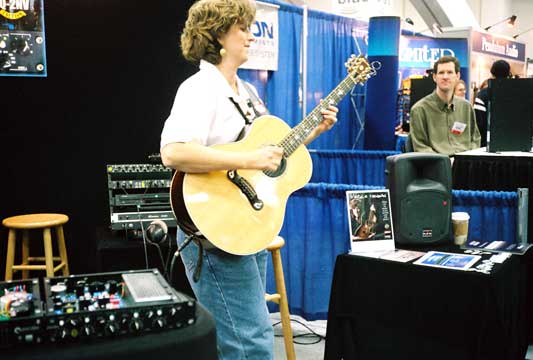
Not all of AES 2004 was technology and papers: here's Vicki Genfan giving show-goers a pleasant acoustic-electric moment.
On the subject of hearing, another neat little paper was Jason Corey's An Ear Training System for Identifying Parameters of Artificial Reverberation in Multichannel Audio, preprint 6262. This was project to design a tool to help listeners get a sense of what artificial reverberation does to sound in a five-channel system, and a program to use it. There were no reports on tests of effectiveness, but anything that tries to educate users in getting a sense of soundstage and acoustic space is a fine idea to my mind.
Juha Merimaa and Wolfgang Hess talked on Training of Listeners for Evaluation of Spatial Attributes of Sound. They looked at some objective measures of soundfield width and depth, which are only usable on a small class of signals, but used them along with sample signals in order to train novice listeners in evaluating soundstaging. Preprint 6237.
Lots of folks had acoustical treatment products at the show, by the way. Don Strahle from Acoustical Solutions (formerly Alpha Acoustics) was there, as were the crews from Acoustics First and Acoustic Systems, and RPG Diffusers. There were also folks from acoustical design outfits like Chris Pelonis from Pelonis Sound and Acoustics and Walter Storyk of the Walter Storyk Design Group. I can't honestly say any of these folks were showing anything different than in previous years but they surely deserve some mention.
Daniel Schobben and Steven van de Par talked on The effect of room acoustics on MP3 audio quality evaluation. They found that excessive room reverberation in playback can mask MP3 encoding problems. This seems kind of obvious, but it's still nice to see it quantized even if they didn't investigate room response issues. Preprint 6239.
In Electronic Bass Trap, Reza Kashani and James Wischmeyer describe a simple device with a microphone, subwoofer, and some electronics which effectively simulates a bass trap in a much smaller area than would be required for conventional bass trapping. It's an active electronic solution to adding acoustic damping to the room itself rather than trying to fix it through the reproduction system, which is always a good plan. Preprint 6277.
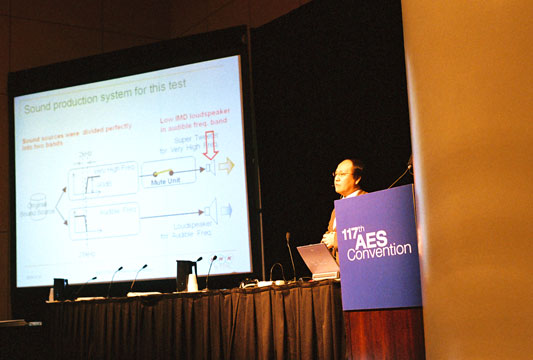
Kimo Hamasaki of NHK delivering AES Paper 6298 (see below).
Finally, no AES show would be complete without a Japanese paper on ultrasonic perception, although this year's is less crazy than most. In Perceptual Discrimination of Very High Frequency Components in Musical Sound Recording with a Newly Developed Wide Frequency Range Microphone, Kimo Hamasaki and three others from NHK use a wideband microphone to record a string quartet, a plucked Japanese instrument called a chikuzen-biwa, and a harpsichord. They then filter this digital into two data streams, one containing material below 20 KHz and the other material above it, using a very sharp digital filter. With a group of thirteen people in front of a B&W Nautilus 801 and a Pioneer PT-R9 supertweeter, they first test to make sure that none of them can hear pure tones reproduced through the supertweeter. They then find that two group members can consistently pick whether the ultrasonic signal is being fed to the supertweeter or not, while the other eleven can't. They don't try uncorrelated noise in the supertweeter in place of the audio file, but although these results are anything but conclusive, this study is phenomenally better-conducted than the presentations at AES shows in the past. Preprint 6298.
It was a good show again this year and there was certainly enough to keep me very busy. And once again I feel like I saw less than half of what I had intended to check out and never saw half the people I meant to see, so expect that this list is very incomplete. But I hope people find this short discussion of what I found interesting to be of use.
